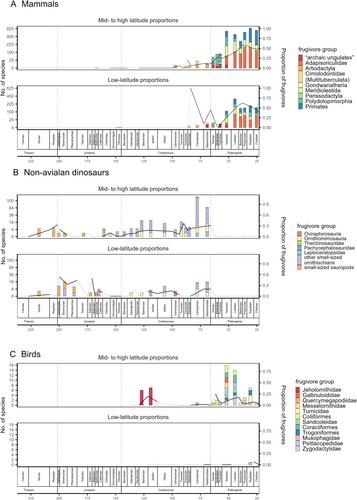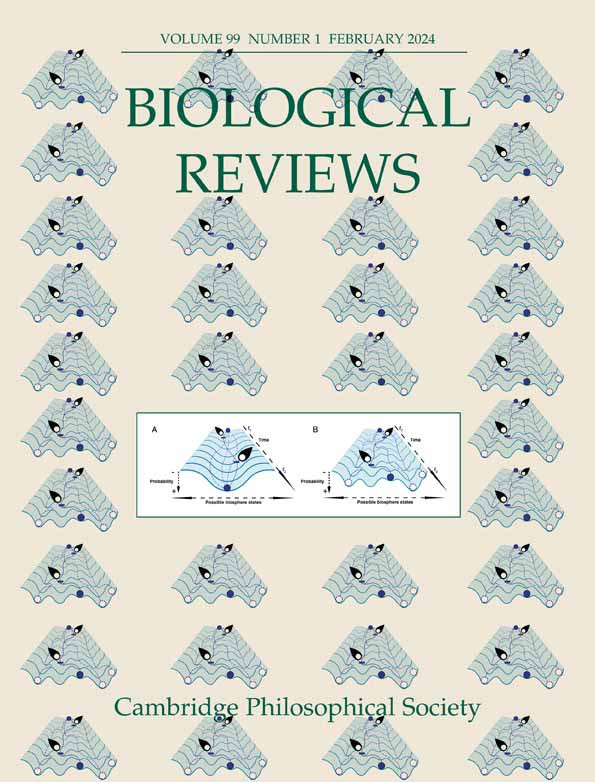晚三叠世-更新世肉质子囊大小和丰度的变化规律
摘要
脊椎动物介导的种子传播是许多生物植物的共同特征,肉质二孢子的大小和丰度变化受区域气候和当今植物区系中脊椎动物种子传播者性质的影响。然而,人们对肉质核果的丰度和大小分布随地质年代发生大规模变化的潜在驱动因素以及地理变化的重要性还知之甚少。这一知识空白非常重要,因为肉质体细胞是光合作用向动物传递能量的一个关键机制,可以在一定程度上解释鸟类和哺乳动物主要类群的多样化。人们提出了各种假说来解释肉质吸虫的丰度和大小分布随时间的变化,包括植物-食草动物的共同进化、被子植物的多样化以及植被结构和气候的变化。我们提供了一个新的数据集,其中包含 800 多个地理参照的二孢化石,时间跨度从三叠纪到更新世,横跨低、中、高古纬度地区。我们以此来量化肉质核果的长期变化模式,研究重要变化的时间和地理背景,以检验潜在的进化和气候解释。我们发现,在白垩纪的大部分时间里,被子植物的肉质果实尺寸都在增大,这正是被子植物从果实较小的草本植物祖先中分化出来的早期。然而,这并没有导致种子植物肉质子囊大小分布发生实质性的净变化,因为至少在晚三叠世,裸子植物已经实现了类似的大小分布。此外,以裸子植物为主的中生代生态系统大多是开放的,而且直到最近的白垩纪,专门化食草动物的比例都很低,这表明植被结构的变化和植物-食草动物的共同进化可能并不是肉质二孢子大小分布的长期重要驱动因素。相反,肉质子囊孢子的大小分布可能在很大程度上受到物理或生命史限制的制约,这些限制是各群体共有的,并随着植物群体向不同的生长形式/大小、栖息地和气候系统扩展而多样化。中生代裸子植物群的肉质二孢子含量较低(50% 的肉质二孢子类群),白垩纪的一些低纬度被子植物群超过了这一水平。始新世的被子植物植物群显示出肉质果实丰度在中高纬度达到了一个高峰,肉质果实的比例非常高,甚至超过了始新世和现在低纬度地区的比例。在始新世-更新世的过渡时期,中高纬度的肉质果实比例大幅下降,导致向更类似于现代的地理分布转变,肉质果实的最高比例出现在低纬度的热带集合体中。这一转变与全球变冷和南半球冰川开始同时发生,表明中高纬度地区的快速变冷导致最有利于被子植物肉质果实生长的气候条件减少。未来的研究可以集中于研究现代肉质果实的环境壁龛,以及气候变化对肉质果实和食俭动物多样性的潜在影响。

Vertebrate-mediated seed dispersal is a common attribute of many living plants, and variation in the size and abundance of fleshy diaspores is influenced by regional climate and by the nature of vertebrate seed dispersers among present-day floras. However, potential drivers of large-scale variation in the abundance and size distributions of fleshy diaspores through geological time, and the importance of geographic variation, are incompletely known. This knowledge gap is important because fleshy diaspores are a key mechanism of energy transfer from photosynthesis to animals and may in part explain the diversification of major groups within birds and mammals. Various hypotheses have been proposed to explain variation in the abundance and size distribution of fleshy diaspores through time, including plant–frugivore co-evolution, angiosperm diversification, and changes in vegetational structure and climate. We present a new data set of more than 800 georeferenced fossil diaspore occurrences spanning the Triassic–Oligocene, across low to mid- to high palaeolatitudes. We use this to quantify patterns of long-term change in fleshy diaspores, examining the timing and geographical context of important shifts as a test of the potential evolutionary and climatic explanations. We find that the fleshy fruit sizes of angiosperms increased for much of the Cretaceous, during the early diversification of angiosperms from herbaceous ancestors with small fruits. Nevertheless, this did not cause a substantial net change in the fleshy diaspore size distributions across seed plants, because gymnosperms had achieved a similar size distribution by at least the Late Triassic. Furthermore, gymnosperm-dominated Mesozoic ecosystems were mostly open, and harboured low proportions of specialised frugivores until the latest Cretaceous, suggesting that changes in vegetation structure and plant–frugivore co-evolution were probably not important drivers of fleshy diaspore size distributions over long timescales. Instead, fleshy diaspore size distributions may be largely constrained by physical or life-history limits that are shared among groups and diversify as a plant group expands into different growth forms/sizes, habitats, and climate regimes. Mesozoic gymnosperm floras had a low abundance of fleshy diaspores (<50% fleshy diaspore taxa), that was surpassed by some low-latitude angiosperm floras in the Cretaceous. Eocene angiosperm floras show a mid- to high latitude peak in fleshy fruit abundance, with very high proportions of fleshy fruits that even exceed those seen at low latitudes both in the Eocene and today. Mid- to high latitude proportions of fleshy fruits declined substantially over the Eocene–Oligocene transition, resulting in a shift to more modern-like geographic distributions with the highest proportion of fleshy fruits occurring in low-latitude tropical assemblages. This shift was coincident with global cooling and the onset of Southern Hemisphere glaciation, suggesting that rapid cooling at mid- and high latitudes caused a decrease in availability of the climate conditions most favourable for fleshy fruits in angiosperms. Future research could be focused on examining the environmental niches of modern fleshy fruits, and the potential effects of climate change on fleshy fruit and frugivore diversity.

 求助内容:
求助内容: 应助结果提醒方式:
应助结果提醒方式:


